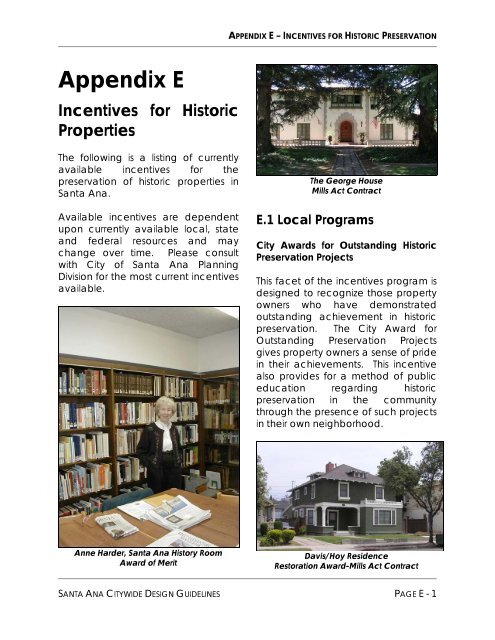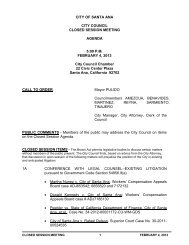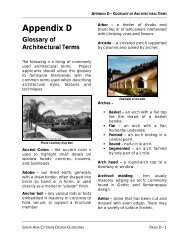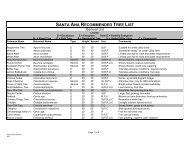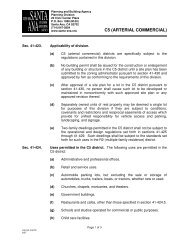Appendix E - Incentives for Historic Preservation - City of Santa Ana
Appendix E - Incentives for Historic Preservation - City of Santa Ana
Appendix E - Incentives for Historic Preservation - City of Santa Ana
You also want an ePaper? Increase the reach of your titles
YUMPU automatically turns print PDFs into web optimized ePapers that Google loves.
<strong>Appendix</strong> E<br />
<strong>Incentives</strong> <strong>for</strong> <strong>Historic</strong><br />
Properties<br />
The following is a listing <strong>of</strong> currently<br />
available incentives <strong>for</strong> the<br />
preservation <strong>of</strong> historic properties in<br />
<strong>Santa</strong> <strong>Ana</strong>.<br />
Available incentives are dependent<br />
upon currently available local, state<br />
and federal resources and may<br />
change over time. Please consult<br />
with <strong>City</strong> <strong>of</strong> <strong>Santa</strong> <strong>Ana</strong> Planning<br />
Division <strong>for</strong> the most current incentives<br />
available.<br />
Anne Harder, <strong>Santa</strong> <strong>Ana</strong> History Room<br />
Award <strong>of</strong> Merit<br />
APPENDIX E – INCENTIVES FOR HISTORIC PRESERVATION<br />
The George House<br />
Mills Act Contract<br />
E.1 Local Programs<br />
<strong>City</strong> Awards <strong>for</strong> Outstanding <strong>Historic</strong><br />
<strong>Preservation</strong> Projects<br />
This facet <strong>of</strong> the incentives program is<br />
designed to recognize those property<br />
owners who have demonstrated<br />
outstanding achievement in historic<br />
preservation. The <strong>City</strong> Award <strong>for</strong><br />
Outstanding <strong>Preservation</strong> Projects<br />
gives property owners a sense <strong>of</strong> pride<br />
in their achievements. This incentive<br />
also provides <strong>for</strong> a method <strong>of</strong> public<br />
education regarding historic<br />
preservation in the community<br />
through the presence <strong>of</strong> such projects<br />
in their own neighborhood.<br />
Davis/Hoy Residence<br />
Restoration Award-Mills Act Contract<br />
SANTA ANA CITYWIDE DESIGN GUIDELINES PAGE E - 1
APPENDIX E – INCENTIVES FOR HISTORIC PRESERVATION<br />
SANTA ANA CITYWIDE DESIGN GUIDELINES PAGE E - 2
<strong>Historic</strong> Designation Marker Program<br />
A <strong>Historic</strong> Designation Marker Program<br />
is a way to promote and educate the<br />
public regarding the value <strong>of</strong> historic<br />
preservation. This component <strong>of</strong> the<br />
incentives program encourages<br />
public awareness <strong>of</strong> local historic<br />
properties and gives property owners<br />
a sense <strong>of</strong> pride.<br />
Each <strong>of</strong> the first 217 properties listed<br />
on the <strong>Santa</strong> <strong>Ana</strong> Register <strong>of</strong> <strong>Historic</strong>al<br />
Properties will be awarded a plaque.<br />
Sample Plaque<br />
If your property is not among those<br />
awarded a plaque, but would like to<br />
order one <strong>for</strong> your historic property,<br />
you may contact the Planning Division<br />
at (714) 647-5804.<br />
APPENDIX E – INCENTIVES FOR HISTORIC PRESERVATION<br />
E.2 State Programs<br />
The Mills Act<br />
The Mills Act grants property tax relief.<br />
It is given <strong>for</strong> homeowners <strong>of</strong> qualified<br />
historic properties. <strong>Historic</strong> properties<br />
that are owner-occupied single-family<br />
residences and income producing<br />
commercial properties are<br />
recognized under the Act. The<br />
property tax relief is given to<br />
encourage property owners to<br />
maintain and preserve their historic<br />
properties. The property owner enters<br />
into a <strong>for</strong>mal agreement with the <strong>City</strong><br />
to establish conditions <strong>for</strong> the<br />
rehabilitation, restoration or<br />
maintenance <strong>of</strong> their property.<br />
F.S. Bishop House<br />
Rehabilitation Award-Mills Act Contract.<br />
The amount <strong>of</strong> tax savings varies, but<br />
Mills Act Agreements can be up to<br />
50% tax savings. The types <strong>of</strong><br />
preservation conditions established by<br />
the Mills Act Agreement also enable<br />
the <strong>City</strong> to specify the standards and<br />
conditions <strong>of</strong> the property’s<br />
preservation. The property owner<br />
SANTA ANA CITYWIDE DESIGN GUIDELINES PAGE E - 3
initiates application <strong>for</strong> entering into a<br />
Mills Act Agreement and acceptance<br />
by the <strong>City</strong> requires approval through<br />
the <strong>Historic</strong> Resources Commission<br />
and acceptance by the <strong>City</strong> Council.<br />
State <strong>Historic</strong> Building Code (SHBC)<br />
Local building <strong>of</strong>ficials may use the<br />
State <strong>Historic</strong> Building Code when<br />
reviewing projects <strong>for</strong> historic<br />
structures on the local, state, and/or<br />
national register as enabled by the<br />
State Health and Safety Code. This<br />
incentive gives the property owner<br />
relief from the strict interpretation <strong>of</strong><br />
the code while maintaining overall<br />
safety standards, which in turn<br />
enables a property owner to maintain<br />
a structure’s unique historic features.<br />
The Phillips Block<br />
Rehabilitation Award<br />
E.3 Federal Programs<br />
Tax <strong>Incentives</strong><br />
The Tax Re<strong>for</strong>m Act <strong>of</strong> 1986 makes tax<br />
credits to encourage preservation.<br />
These include:<br />
APPENDIX E – INCENTIVES FOR HISTORIC PRESERVATION<br />
• 20% rehabilitation tax credit<br />
equal to 20% <strong>of</strong> the amount<br />
spent in a certified<br />
rehabilitation <strong>of</strong> a certified<br />
historic structure or;<br />
• 10% rehabilitation tax credit<br />
equal to 10% <strong>of</strong> the amount<br />
spent in a certified<br />
rehabilitation <strong>of</strong> a non-historic<br />
structure that was built prior to<br />
1936.<br />
A tax credit is different from a tax<br />
deduction because a deduction<br />
lowers the amount <strong>of</strong> income that is<br />
ultimately taxed, but a credit lowers<br />
the amount <strong>of</strong> tax owed. For both<br />
credits, the rehabilitation must be a<br />
substantial one (i.e., exceeds<br />
$5,000.00 or the adjusted basis <strong>of</strong> the<br />
property, whichever is greater), and<br />
must involve a depreciable building.<br />
This incentive is sponsored and<br />
implemented by the federal<br />
government. The two tax credits are<br />
mutually exclusive, so a property<br />
owner cannot use both <strong>for</strong> the same<br />
building.<br />
To utilize the 20% tax credit, the<br />
property owner must file a two-part<br />
application with the National Parks<br />
Service. Part I <strong>of</strong> the application<br />
ensures that the building is a certified<br />
historic structure used <strong>for</strong> a<br />
commercial purpose. This<br />
certification indicates that the<br />
property contributes to the historic<br />
district in which it is located OR that<br />
the building is individually listed or<br />
eligible <strong>for</strong> listing on the National<br />
SANTA ANA CITYWIDE DESIGN GUIDELINES PAGE E - 4
Register. Part II <strong>of</strong> the application<br />
certifies that the rehabilitation work<br />
meets the Secretary <strong>of</strong> the Interior’s<br />
Standards. These standards are<br />
nationally accepted guidelines<br />
concerning any work to be<br />
per<strong>for</strong>med on a property designated<br />
as historic. A lessee may be eligible<br />
<strong>for</strong> the tax credits if their lease term is<br />
<strong>for</strong> thirty-nine (39) years or more.<br />
Old <strong>City</strong> Hall<br />
Federal Income Tax Credit<br />
To be eligible <strong>for</strong> the 10% tax credit,<br />
the building must not be historic, but<br />
the building must be used <strong>for</strong> a<br />
commercial purpose, and built prior<br />
to 1936. Property owners apply<br />
directly to the federal government in<br />
order to participate, and must also file<br />
Parts I and II <strong>of</strong> the application. In this<br />
APPENDIX E – INCENTIVES FOR HISTORIC PRESERVATION<br />
case, Part I <strong>of</strong> the application certifies<br />
that the structure is not historic, or<br />
does not contribute to a historic<br />
district. Although non-historic<br />
buildings are not required to meet the<br />
Secretary <strong>of</strong> the Interior’s Standards,<br />
Part II <strong>of</strong> the application <strong>for</strong> the 10%<br />
credit ensures that the project meets<br />
the following physical requirements:<br />
• at least 50% <strong>of</strong> the building’s<br />
walls existing at the time the<br />
rehabilitation began must<br />
•<br />
remain in place as external<br />
walls at the work’s conclusion,<br />
and<br />
at least 75% <strong>of</strong> the building’s<br />
existing external walls must<br />
remain in place as either<br />
•<br />
external or internal walls, and<br />
at least 75% <strong>of</strong> the building’s<br />
internal structural framework<br />
must remain in place.<br />
For both the 10% and 20% tax credits,<br />
preliminary fees <strong>for</strong> the applicant<br />
range from $250 to $2500 depending<br />
upon the cost <strong>of</strong> the rehabilitation.<br />
Preliminary fees are deducted from<br />
the final fee. Applicants are strongly<br />
encouraged to submit applications<br />
describing proposed work and to<br />
receive approval from the National<br />
Parks Service prior to the start <strong>of</strong><br />
construction. Owners who undertake<br />
rehabilitation projects without prior<br />
approval do so at their own risk.<br />
Additionally, applicants should consult<br />
with current tax laws and other<br />
applicable legislation.<br />
SANTA ANA CITYWIDE DESIGN GUIDELINES PAGE E - 5
Ebell Club Presidents - Award <strong>of</strong> Merit<br />
Additional Programs and <strong>Incentives</strong><br />
For the most current in<strong>for</strong>mation on<br />
programs and incentives, please<br />
contact the <strong>City</strong> <strong>of</strong> <strong>Santa</strong> <strong>Ana</strong><br />
Planning Division at (714) 647-5804.<br />
APPENDIX E – INCENTIVES FOR HISTORIC PRESERVATION<br />
SANTA ANA CITYWIDE DESIGN GUIDELINES PAGE E - 6


